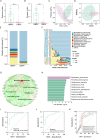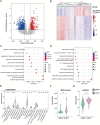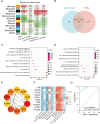Integrative study of pulmonary microbiome, transcriptome and clinical outcomes in Mycoplasma pneumoniae pneumonia
- PMID: 38238712
- PMCID: PMC10795342
- DOI: 10.1186/s12931-024-02687-4
Integrative study of pulmonary microbiome, transcriptome and clinical outcomes in Mycoplasma pneumoniae pneumonia
Abstract
Background: This study aimed to investigate the interactions among three core elements of respiratory infection-pathogen, lung microbiome, and host response-and their avocation with the severity and outcomes of Mycoplasma pneumoniae pneumonia (MPP) in children.
Methods: We prospectively collected bronchoalveolar lavage fluid from a cohort of 41 children with MPP, including general MPP (GMPP) and complicated MPP (CMPP), followed by microbiome and transcriptomic analyses to characterize the association among pathogen, lung microbiome, and host response and correlate it with the clinical features and outcomes.
Results: The lung microbiome of patients with CMPP had an increased relative abundance of Mycoplasma pneumoniae (MP) and reduced alpha diversity, with 76 differentially expressed species. Host gene analysis revealed a key module associated with neutrophil function and several inflammatory response pathways. Patients with a high relative abundance of MP, manifested by a specific lung microbiome and host response type, were more prone to CMPP and had a long imaging recovery time.
Conclusion: Patients with CMPP have a more disrupted lung microbiome than those with GMPP. MP, lung microbiome, and host response interacts with each other and are closely related to disease severity and outcomes in children with MPP.
Keywords: Host response; Microbiome; Mycoplasma pneumoniae; Neutrophils; Outcomes.
© 2024. The Author(s).
Conflict of interest statement
The authors declare that they have no conflicts of interest.
Figures






References
-
- Yang TI, Chang TH, Lu CY, Chen JM, Lee PI, Huang LM, et al. Mycoplasma pneumoniae in pediatric patients: do macrolide-resistance and/or delayed treatment matter? J Microbiol Immunol Infect. 2019;52(2):329–35. - PubMed
-
- de Benedictis FM, Kerem E, Chang AB, Colin AA, Zar HJ, Bush A. Complicated pneumonia in children. Lancet. 2020;396(10253):786–98. - PubMed
MeSH terms
Substances
Grants and funding
- 82200008/the Youth Program of National Natural Science Foundation of China
- YKK22162/Nanjing Health Bureau Medical Science and Technology Development Foundation
- BE2019607/Grants from Jiangsu Province Special Funds for Key Program (Social Development)
- 82270008/the General Program of National Natural Science Foundation of China
LinkOut - more resources
Full Text Sources

